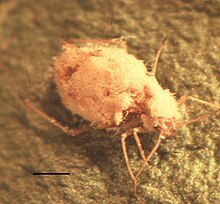
Back Grüne Pfirsichblattlaus ALS أرق الدراقن الأطحل Arabic ارق الدراقن الاطحل ARZ Şaftalı mənənəsi Azerbaijani সাদা মাছি Bengali/Bangla Pugó verd del préssec Catalan Myzus persicae CEB Mšice broskvoňová Czech Grüne Pfirsichblattlaus German Myzus persicae Spanish
| Myzus persicae | |
|---|---|

| |
| Scientific classification | |
| Domain: | Eukaryota |
| Kingdom: | Animalia |
| Phylum: | Arthropoda |
| Class: | Insecta |
| Order: | Hemiptera |
| Suborder: | Sternorrhyncha |
| Family: | Aphididae |
| Genus: | Myzus |
| Species: | M. persicae
|
| Binomial name | |
| Myzus persicae | |

Myzus persicae, known as the green peach aphid, greenfly, or the peach-potato aphid,[2] is a small green aphid belonging to the order Hemiptera. It is the most significant aphid pest of peach trees, causing decreased growth, shrivelling of the leaves and the death of various tissues. It also acts as a vector for the transport of plant viruses such as cucumber mosaic virus (CMV), potato virus Y (PVY) and tobacco etch virus (TEV). Potato virus Y and potato leafroll virus can be passed to members of the nightshade/potato family (Solanaceae), and various mosaic viruses to many other food crops.[3]
Originally described by Swiss entomologist Johann Heinrich Sulzer in 1776, its specific name is derived from the Latin genitive persicae, "of the peach".[4] The syntype specimen of this species is located in the Illinois Natural History Survey Insect Collection.[5]
- ^ "Myzus persicae (Sulzer, 1776)". itis.gov. ITIS Report. Retrieved December 12, 2020.
Myzus persicae (Sulzer, 1776) – green peach aphid, puceron vert du pêcher
- ^ Bass, C; Puinean, A.M; Zimmer, C.T; Denholm, I; Field, L.M (2014). "The evolution of insecticide resistance in the peach potato aphid, Myzus persicae". Department of Biological Chemistry and Crop Protection, Rothamsted Research, Harpenden. Insect Biochemistry and Molecular Biology. 51. United Kingdom (published May 20, 2014): 41–51. doi:10.1016/j.ibmb.2014.05.003. hdl:2299/19394. ISSN 0965-1748. PMID 24855024.
The peach potato aphid, Myzus persicae is a globally distributed crop pest with a host range of over 400 species including many economically important crop plants. The intensive use of insecticides to control this species over many years has led to populations that are now resistant to several classes of insecticide.
- ^ Capinera, John L. (October 2005). "Featured creatures". University of Florida website - Department of Entomology and Nematology. University of Florida. Retrieved 2009-09-07.
- ^ Simpson, D.P. (1979). Cassell's Latin Dictionary (5 ed.). London: Cassell Ltd. ISBN 0-304-52257-0.
- ^ "Occurrence Detail 3801373202". www.gbif.org. Retrieved 2022-11-21.
© MMXXIII Rich X Search. We shall prevail. All rights reserved. Rich X Search